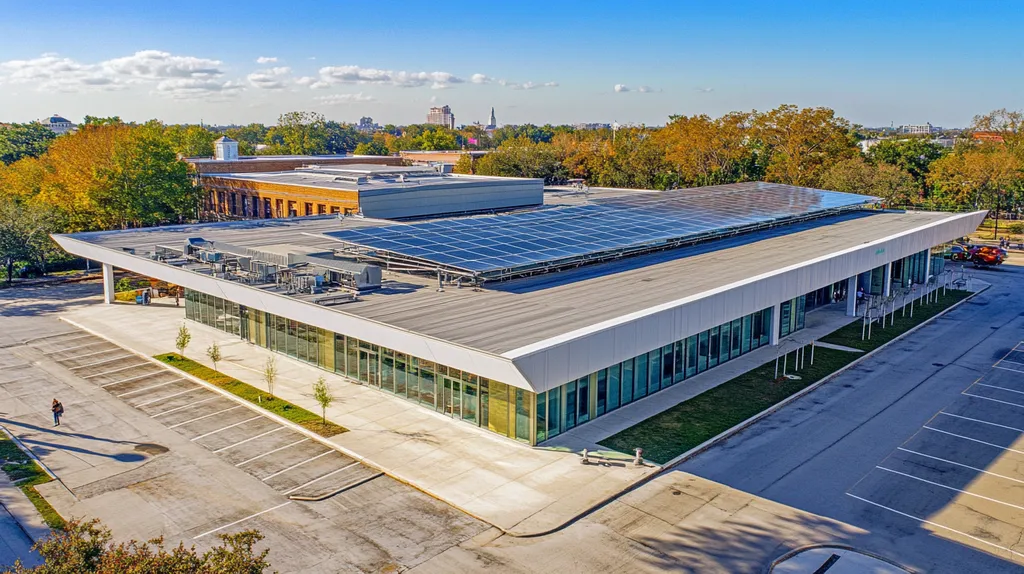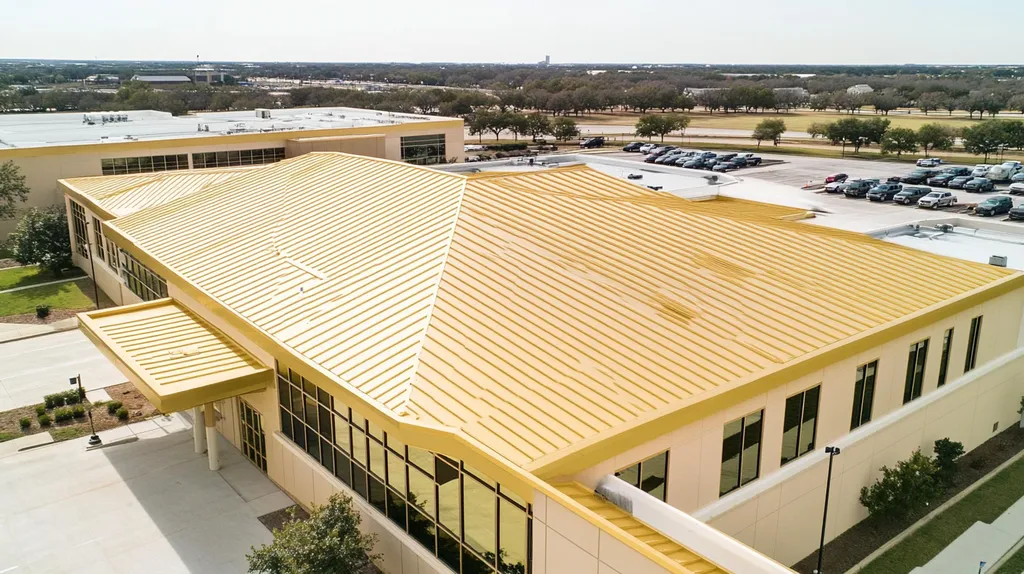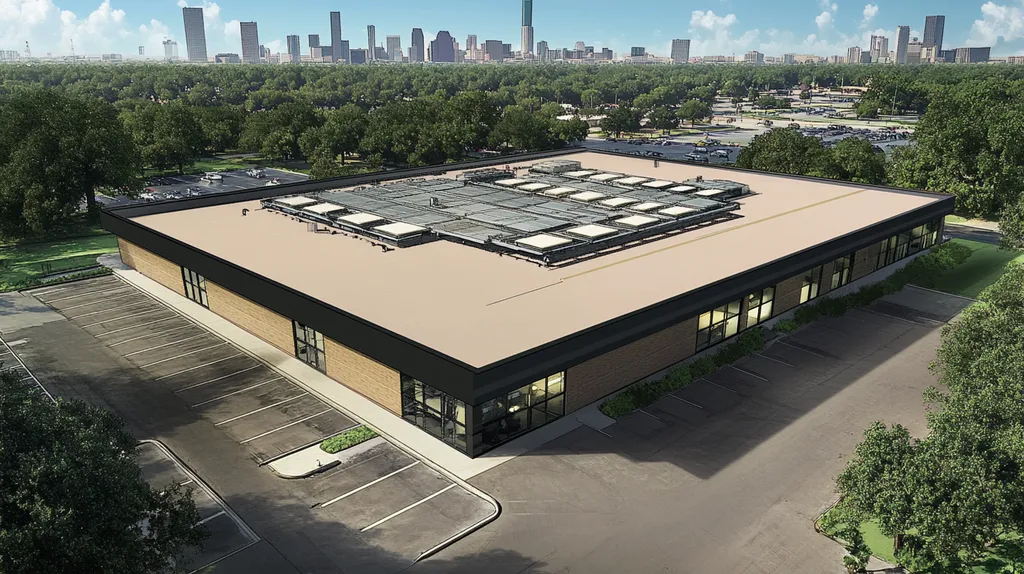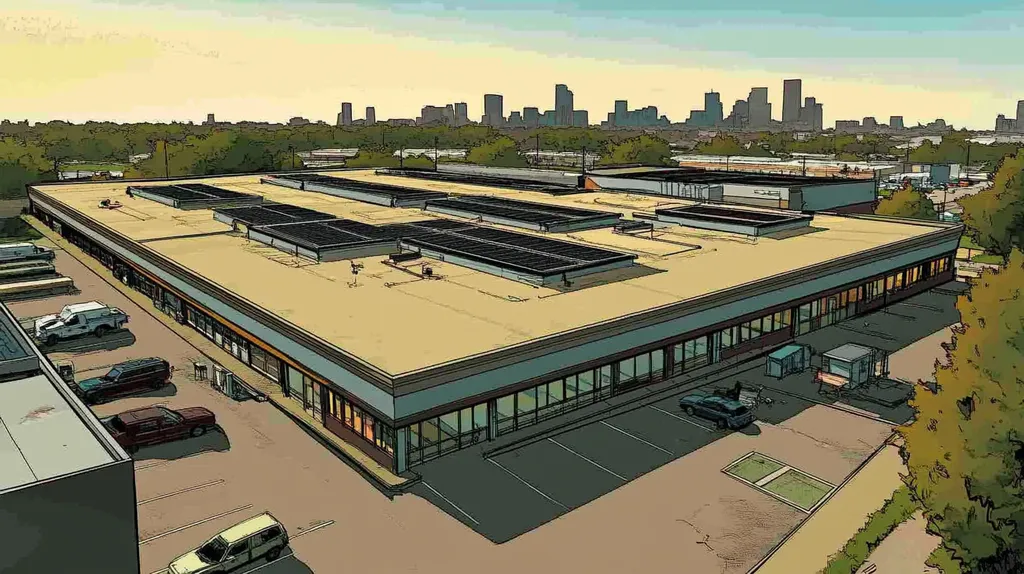Each year, inadequate roof drainage costs commercial property owners millions in structural damage and premature roof replacement. Industry studies show that up to 80% of all roof failures stem from water-related issues that proper drainage could have prevented.
For facility managers and property owners, understanding and implementing effective drainage practices isn’t just about maintenance—it’s about protecting their entire investment.
This comprehensive guide examines critical aspects of commercial roof drainage, from fundamental concepts and system components to implementation methods and maintenance requirements that ensure optimal performance and longevity.
SECTION 1: FUNDAMENTAL CONCEPTS
Effective roof drainage is vital to the durability and functionality of commercial roofs. Research indicates that poor drainage contributes to premature roof failure in about 80% of cases. By grasping the significance of efficient drainage systems, property owners and facility managers can take essential steps to protect their investments and ensure their roofs perform optimally over time.
Importance of Roof Drainage
Robust roof drainage systems are paramount for managing water runoff and safeguarding commercial properties from potential damage. Water accumulation not only adds excessive weight but can also compromise the structural integrity of a building. Additionally, effective drainage ensures that rooftops remain usable and prevents water from seeping into internal spaces.
Sound drainage practices can enhance energy efficiency as well. When water pools, it intensifies thermal absorption, which can drive cooling costs higher. Conversely, a well-designed drainage system helps maintain a stable roof temperature, resulting in lower energy expenses.
Moreover, a properly drained roof promotes a safer working environment. Stagnant water can encourage pests and foster the growth of harmful mold or mildew, creating health risks for building occupants. Property managers must prioritize the upkeep of these systems to protect both employees and the structural integrity of the facility.
To that end, regular inspections and maintenance of drainage systems are crucial. These practices allow for timely identification and resolution of clogs or damages, preventing further complications and significantly extending the roof’s lifespan.
Consequences of Ponding Water
Ponding water represents a serious threat in commercial roofing, leading to a range of complications. When water collects on the surface, it becomes a breeding ground for bacteria and fungi, which can be detrimental to occupant health. Additionally, stagnant water can deteriorate roofing materials, leading to accelerated wear and, ultimately, roof failure.
The weight from standing water can exceed design limits, raising the risk of structural damage. Roofs are typically engineered to withstand certain loads, and prolonged water accumulation can push these limits, creating a potential safety hazard. As ponding persists, the need for repairs can increase in frequency and cost.
The financial implications of neglected ponding are considerable. Stagnant water can lead to rapidly escalating emergency repair and replacement costs. Facilities grappling with these challenges risk not only operational disruptions but also their overall financial health, making effective drainage strategies a critical component of roofing maintenance.
Ignoring ponding water can result in severe consequences for any commercial property. Quick action can transform minor issues into significant financial burdens, preventing unforeseen delays and extensive repairs.
Role of Positive Drainage
Positive drainage is an essential principle in commercial roofing, designed to guide water towards designated drainage areas through intentional slopes. This technique significantly reduces the chances of ponding, prolonging the life of the roofing system. Flat roofs without sufficient slope can invite various detrimental issues.
Implementing positive drainage not only boosts performance but also simplifies maintenance tasks. Roofs with appropriate slopes facilitate easier cleaning and inspections, as water and debris flow naturally towards drains. This proactive approach can minimize downtime, reducing repair costs and keeping operations running smoothly.
Additionally, effective drainage designs can enhance a building’s overall energy efficiency. By ensuring that water drains swiftly and efficiently, the roof maintains a consistent temperature, which lowers energy demands for climate control inside the building.
Considering positive drainage shouldn’t be an afterthought. During the construction or maintenance of a commercial roof, prioritizing proper drainage should be a fundamental design requirement. Following these practices can protect investments and mitigate common roofing challenges, ultimately paying dividends over the roof’s lifespan.
SECTION 2: SYSTEM COMPONENTS
Effective water drainage is critical for the longevity of commercial roofs. Standing water is not just a nuisance; it can lead to leaks, structural damage, and expensive repairs. By understanding the essential components of roof drainage systems, property owners and facility managers can prioritize maintenance and enhance the overall health of their buildings. Important components include gutters and downspouts, interior drains and scuppers, as well as advanced systems like siphonic and gravity solutions.
Gutters and Downspouts
Gutters and downspouts form the first line of defense against water accumulation on commercial roofs. When properly sized and installed, they efficiently direct rainwater away from the roof’s surface. However, if gutters become clogged or are improperly sloped, they can overflow, causing water to pool and leading to potential roof damage.
Routine maintenance of gutters is essential. Regular cleaning helps prevent debris buildup that can block water from flowing freely. Property owners should prioritize inspections, especially after heavy storms or seasonal changes to ensure gutters remain clear and functional.
Choosing the right materials also plays a significant role in the longevity of gutters. Sturdy options like aluminum or copper resist corrosion and provide lasting performance, helping reduce the frequency of replacements and the associated costs.
Strategic placement of downspouts is equally important. Downspouts should be positioned to channel water well away from the building’s foundation. Misplacement can lead to backflow or flooding, posing additional risks that could compromise the structural integrity of the facility.
Interior Drains and Scuppers
Interior drains and scuppers are vital for effective water evacuation from flat commercial roofs. Interior drains are strategically installed within the roof, allowing water to flow directly into the building’s drainage system. This setup minimizes water pooling and mitigates the risk of leaks or structural problems.
Scuppers, typically located along parapet walls, allow water to exit the roof over its edge. While they are effective, it is crucial to size them correctly according to the roof area—an incorrect size can lead to overspills and negatively impact the roof’s stability.
Regular inspections and maintenance are critical for both systems. Debris can accumulate and cause blockages, increasing the likelihood of water-related issues. A proactive approach to these inspections ensures these drainage components operate effectively and efficiently.
Combining interior drains with scuppers creates a more robust drainage system. This dual approach not only enhances drainage efficiency but also provides additional protection against the risks associated with water accumulation.
Siphonic and Gravity Systems
Siphonic and gravity drainage systems represent advanced solutions available for commercial roofing. Gravity systems use the natural slope of the roof to guide water toward designated drains. Their straightforward design is effective, but they require precise placement of drains to prevent water build-up.
Siphonic systems, by contrast, leverage vacuum pressure to move water quickly and efficiently. These systems are capable of handling larger volumes of water, making them particularly beneficial for buildings in regions with heavy rainfall. The design allows for fewer drains, simplifying installation and reducing potential points of failure.
Installations of these systems require meticulous planning. Understanding the roof’s layout and local weather patterns is crucial to determining which system will work best. A poorly planned drainage system can lead to costly repairs and a reduced lifespan for the roof.
Both siphonic and gravity systems necessitate regular maintenance to function optimally. Consistent inspections and cleaning help prevent clogs and ensure that water flows as intended, offering peace of mind to property owners and safeguarding their investment.
SECTION 3: IMPLEMENTATION METHODS
Proper water drainage on commercial roofs is essential for preventing significant damage and prolonging the lifespan of the roofing system. Research shows that neglecting proper drainage design can cut a roof’s lifespan by up to 50%. This section discusses critical implementation methods such as climate considerations, strategic drain placement, and tapered insulation strategies that can help property owners and facility managers effectively manage water runoff.
Designing for Climate and Roof Size
Climate plays a crucial role in shaping effective drainage solutions for commercial roofs. In regions experiencing heavy rainfall or significant snowfall, roofs must be equipped to handle excess water. This ensures that water doesn’t pool, which can lead to leaks or damage to the structure.
The size of the roof also dictates the complexity of the drainage system. Larger roofs often require more advanced solutions, such as multiple drains or scuppers, to handle the volume of water efficiently. On the other hand, smaller roofs may only need simpler designs, making them easier to maintain.
Innovative design features, like adjustable scupper heights, can enhance drainage efficiency by adapting to changing weather conditions. This adaptability helps to ensure that the system performs optimally throughout the year.
Failure to consider these vital elements may lead to drainage failures, costing property owners significantly in emergency repairs or the need for early replacements.
Strategic Placement of Drains
The positioning of drains is vital in promoting effective water flow across a roof. Drains should be placed in the lowest areas, allowing gravity to facilitate quick water removal. This setup minimizes the risk of pooling and significantly reduces the likelihood of leaks.
For larger roofs, installing multiple drains can further enhance water management, preventing overloading a single drainage point. Strategic planning should also avoid placing drains near rooftop units, which can hinder water flow.
Conducting a detailed site analysis during the planning stage can reveal optimal drain locations based on existing roof contours. This proactive approach can prevent future drainage complications and ensure the roof functions at peak efficiency.
Ignoring these planning aspects could result in substantial water damage, jeopardizing the integrity of the roof and the building itself.
Tapered Insulation for Slope
Tapered insulation is a game-changer when it comes to directing water toward drains while boosting the roof’s overall performance. By creating a slope, tapered insulation guides water flow to specific drainage points, significantly reducing standing water.
The insulation design must cater to the roof’s specific requirements. Different materials and thicknesses facilitate the creation of the required slope efficiently, ensuring optimal water drainage.
Moreover, tapered insulation can enhance thermal performance, providing energy efficiency benefits. This dual purpose not only aids drainage but also reduces heating and cooling costs over time.
Neglecting to incorporate tapered insulation can lead to stagnant water waste and premature wear on the roof, resulting in costly repairs and a dramatically shorter lifespan for the roofing system.
SECTION 4: MAINTENANCE REQUIREMENTS
Regular maintenance is not just advisable; it is essential for keeping water drainage systems on commercial roofs functioning effectively. Neglecting routine care can lead to costly repairs and even structural failures. Alarmingly, research shows that nearly 20% of roofing failures are a direct result of insufficient maintenance. By implementing consistent cleaning and inspection protocols, property owners and facility managers can significantly reduce the chances of water accumulation and enhance the roof’s longevity. This section will highlight crucial maintenance tasks, including regular cleaning, preventing clogs, and post-storm drain clearance.
Regular Cleaning and Inspection
Routine cleaning and inspection are fundamental components of effective drainage maintenance. Roof surfaces must be cleared of debris—such as leaves, dirt, and trash—at least twice a year, ideally during spring and fall. Keeping a clean roof drastically lowers the risk of water pooling, which could cause extensive damage over time.
During inspections, it’s vital to examine all drainage systems, including gutters, downspouts, and scuppers. Looking for signs of wear or damage allows issues to be addressed before they escalate into major problems. This proactive strategy not only guarantees efficient drainage but also helps maintain warranties on roofing materials.
Employing professional services for thorough inspections can be valuable. Experts can detect hidden problems and recommend targeted maintenance. Establishing a scheduled tracking system for inspections contributes to early detection, reducing long-term maintenance costs significantly.
Preventing Clogs and Blockages
Clogs and blockages pose serious threats to effective drainage, potentially resulting in considerable damage and expensive repairs. Preventive measures are essential in averting these issues. Installing mesh screens around roof drains can efficiently capture debris while allowing water to flow freely, supporting seamless drainage.
In addition to physical barriers, routine inspections should zero in on areas prone to blockages. Low points on the roof are notorious for accumulating debris, requiring more frequent checks. Promptly addressing these “hot spots” is critical for maintaining optimal drainage performance.
Education plays a vital role as well. Property management teams should be trained to identify warning signs of impending clogs, such as slow drainage during rainfall. Ongoing training on maintenance practices empowers teams to respond quickly, lessening the risk of water-related damage.
Post-Storm Drain Clearance
After a storm, immediate clearance of drains and gutters is crucial. Heavy rainfall can create significant debris buildup, making it essential to inspect and clear these areas promptly. Delaying this action can lead to water pooling, which fosters leaks and potential structural damage.
It’s also important to assess the roof’s structural integrity following severe weather events, as unexpected damage may arise. Conducting thorough inspections after storms allows for the identification of issues that might not be immediately visible. Property managers should have a storm response plan that details clear procedures for post-storm checks.
Ultimately, swift post-storm maintenance helps minimize costly repairs and protects the overall roofing system. Collaborating with professional roofing services for post-storm evaluations ensures that all potential issues are identified and addressed without delay.
SECTION 5: PERFORMANCE METRICS
Effective water drainage on commercial roofs is vital to preventing structural damage and reducing potential repair costs. Inadequate drainage can result in water accumulation, which not only leads to leaks but also poses a risk to the integrity of the entire property. By closely monitoring performance metrics, property owners and facility managers can assess the effectiveness of their roof drainage systems. This section highlights critical metrics, including water flow efficiency, structural integrity monitoring, and leak detection and reporting, which play a significant role in protecting a facility’s financial stability.
Water Flow Efficiency
Water flow efficiency is essential for maintaining a roof’s durability and avoiding damage. A properly designed drainage system must effectively channel water away from vulnerable areas to prevent pooling. Facility managers should conduct regular evaluations of downspouts, drains, and scuppers to confirm they are operational and effective.
By monitoring water flow rates during heavy rainfall, property owners can identify areas where water gets trapped and may need further drainage solutions. Implementing practices such as ensuring clear pathways for drainage can drastically enhance this efficiency. Regular cleaning of gutters and drains helps prevent blockages that can impede water flow.
Utilizing specialized instruments to measure water flow can yield valuable insights, empowering teams to make informed maintenance decisions. Regular performance assessments not only extend the lifespan of the roof but also enhance energy efficiency by minimizing heat buildup caused by stagnant water.
In essence, proactive measures to enhance water flow efficiency are crucial for safeguarding the roof and maintaining optimal performance over time.
Structural Integrity Monitoring
Monitoring a roof’s structural integrity is critical for identifying potential drainage issues before they escalate into major problems. Regular inspections can reveal early warning signs such as sagging or uneven surfaces, often signaling underlying water accumulation concerns. Without diligent monitoring, minor issues may escalate into significant structural failures.
Advanced technologies such as drones and thermal imaging facilitate comprehensive inspections with minimal risk. These tools can detect moisture beneath the roofing layers, allowing maintenance teams to act swiftly before complications worsen. Regular thermal scans may also help identify areas of heat loss associated with inadequate drainage.
Establishing a consistent inspection schedule that aligns with seasonal changes is essential. For example, heavy rainfall can expose weaknesses in the drainage system that require prompt attention. Implementing routine assessments reduces the risk of serious damage and extends the roof’s lifespan.
Investing in structural integrity monitoring not only safeguards the facility but can also lead to significant savings on repairs and replacement costs.
Leak Detection and Reporting
Effective leak detection and reporting systems are vital for minimizing the damage caused by water intrusion. A proactive leak detection strategy allows for quick identification and resolution of leaks that can harm roofing, insulation, and building interiors. Routine inspections combined with advanced leak detection technology significantly lower risks associated with water damage.
Property owners should consider integrating moisture sensors, acoustic detection devices, and systematic inspections to develop a thorough leak detection strategy. Detecting leaks early enables facility managers to address issues swiftly, potentially averting expensive repairs and creating unsafe conditions.
Having a solid reporting system for leak detection fosters accountability among maintenance teams and helps ensure that no issue is overlooked. Encouraging a culture of prompt reporting among frontline staff can enhance response times and improve overall facility management.
By enhancing leak detection practices and prioritizing timely reporting, property managers better protect their assets and maintain operational continuity.
SECTION 5: PERFORMANCE METRICS
Effective water drainage on commercial roofs isn’t just an option—it’s a necessity for avoiding structural damage and costly repairs. Insufficient drainage can cause water to collect, leading to roof leaks and potentially severe property damage. To guard against these risks, monitoring performance metrics is essential to determine the efficacy of a roof’s drainage system. This section delves into key metrics, including water flow efficiency, structural integrity monitoring, and leak detection and reporting, all of which significantly influence a facility’s financial health.
Water Flow Efficiency
Water flow efficiency is crucial for extending a roof’s lifespan and preventing damage. A well-designed drainage system must effectively channel water away from critical areas to avoid pooling. Facility managers should routinely inspect downspouts, drains, and scuppers to confirm they are functioning optimally.
By monitoring water flow rates during heavy rainfall, property owners can pinpoint areas where water may be trapped and implement additional drainage solutions if necessary. Maintaining clear drainage pathways is also key to optimizing efficiency. Regular cleaning of gutters and drains helps prevent clogs that could impede water flow.
Utilizing specialized tools to measure water flow can provide valuable insights, enabling teams to make informed decisions. Routine performance evaluations not only extend the life of the roof but also enhance energy efficiency by reducing heat accumulation due to stagnant water.
In summary, proactive maintenance efforts aimed at improving water flow efficiency are essential for safeguarding the roof and ensuring it performs at its best for years to come.
Structural Integrity Monitoring
Monitoring the structural integrity of a roof is vital for catching drainage issues before they escalate. Regular inspections can reveal early signs of stress, such as sagging or uneven surfaces, often indicative of hidden water accumulation. Without diligent oversight, small problems can quickly evolve into significant structural failures.
Advanced technologies like drones and thermal imaging enable thorough inspections with minimal risk involved. These tools can help uncover moisture lurking beneath roofing layers, allowing maintenance teams to act swiftly before complications worsen. Regular thermal scans can also identify areas of heat loss tied to poor drainage conditions.
It’s crucial to establish a consistent inspection routine aligned with seasonal changes. For instance, heavy rains can expose weaknesses in drainage systems that need immediate attention. By implementing these monitoring practices, property owners can mitigate the risk of severe damage and extend the roof’s service life.
Investing in structural integrity monitoring safeguards the facility while also potentially leading to significant savings on repairs and replacement costs.
Leak Detection and Reporting
Effective leak detection and reporting systems play a crucial role in minimizing damage from water intrusion. A proactive leak detection strategy allows for the early identification and resolution of leaks that threaten roofing, insulation, and building interiors. Routine inspections, supported by advanced leak detection technology, can significantly decrease water damage risks.
Property owners should consider using moisture sensors, acoustic detection devices, and systematic inspections to create a robust leak detection framework. Promptly addressing leaks helps facility managers avoid costly repairs and unsafe conditions.
A solid reporting system for leak detection encourages accountability among maintenance teams and ensures that no issue goes unnoticed. Fostering an open communication channel among frontline staff can enhance reporting efficiency and overall response times.
By prioritizing leak detection and establishing a culture of prompt reporting, property managers can better protect their investments and maintain smooth operational continuity.
The Bottom Line
With water damage accounting for over 80% of commercial roof failures and billions in annual repair costs, implementing proper drainage is not optional—it’s essential for protecting valuable property investments.
Through strategic system design, regular maintenance, and performance monitoring, facility managers can dramatically reduce the risk of catastrophic water damage.
The most successful drainage solutions combine carefully selected components, climate-appropriate implementation methods, and rigorous maintenance protocols.
Moving forward, emerging technologies like smart sensors and advanced monitoring systems will continue revolutionizing how buildings manage water drainage.
For property owners and facility managers, the message is clear: proactive drainage management today prevents costly failures tomorrow.
FREQUENTLY ASKED QUESTIONS
Q. Why is effective drainage crucial for commercial roofs?
A. Effective drainage prevents premature roof failure, reducing repair costs. Water accumulation adds excess weight and risks structural damage while fostering pests and mold, impacting occupant health. Regular maintenance is necessary to ensure optimal roof performance.
Q. What components are critical for a commercial roof drainage system?
A. Key components include gutters, downspouts, interior drains, and scuppers. Proper sizing and maintenance of these elements ensure efficient water flow and prevent pooling, which can lead to serious damage over time.
Q. How should drains be placed on a commercial roof?
A. Drains should be positioned in the lowest areas to facilitate quick water removal through gravity. For larger roofs, multiple drains prevent water overload and pooling, significantly reducing risks associated with stagnant water and leaks.
Q. What maintenance is required for commercial roof drainage?
A. Regular cleaning and thorough inspections are essential for maintaining drainage systems. Ensuring gutters and drains are clear of debris prevents clogs and pooling, which risks significant structural damage and costly repairs.
Q. What metrics should be monitored for drainage performance?
A. Key metrics include water flow efficiency, structural integrity, and leak detection. Regular evaluations ensure systems perform effectively, preventing costly damage and prolonging the roof’s lifespan by allowing early intervention.
Q. How can climate affect commercial roof drainage designs?
A. Climate influences the design of drainage systems, especially in areas with heavy rainfall or snowfall. These roofs need specialized features to prevent water accumulation and potential leaks, thus maintaining structural integrity.
Q. What is tapered insulation in commercial roofing?
A. Tapered insulation is designed to create slopes that direct water toward drainage points. This configuration helps minimize ponding and enhances thermal efficiency, reducing heating and cooling costs while keeping roofs functional over time.











